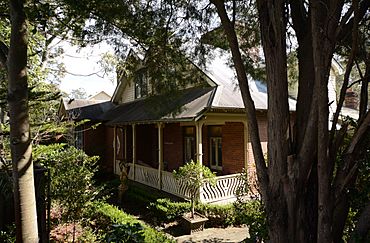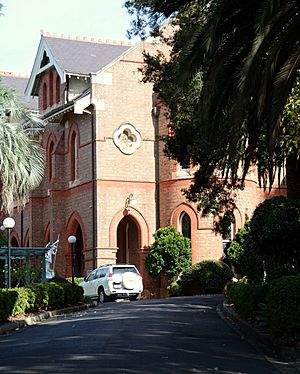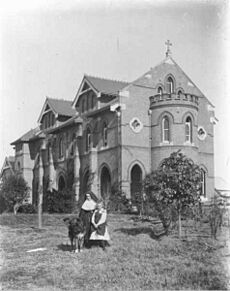Normanhurst, New South Wales facts for kids
Quick facts for kids NormanhurstSydney, New South Wales |
|||||||||||||||
|---|---|---|---|---|---|---|---|---|---|---|---|---|---|---|---|

Gilligaloola, family home of Norman Selfe, after which the suburb was named.
|
|||||||||||||||
| Population | 5,387 (2021 census) | ||||||||||||||
| • Density | 2,482/km2 (6,430/sq mi) | ||||||||||||||
| Postcode(s) | 2076 | ||||||||||||||
| Elevation | 169 m (554 ft) | ||||||||||||||
| Area | 2.17 km2 (0.8 sq mi) | ||||||||||||||
| Location | 23 km (14 mi) NW of Sydney CBD | ||||||||||||||
| LGA(s) | Hornsby Shire | ||||||||||||||
| State electorate(s) | Wahroonga | ||||||||||||||
| Federal Division(s) | |||||||||||||||
|
|||||||||||||||
Normanhurst is a suburb located in the Upper North Shore area of Sydney, Australia. It's about 22 kilometers north-west of Sydney's city center. This area is part of the Hornsby Shire local government.
Contents
Exploring Normanhurst's Past
How Normanhurst Got Its Name
Did you know that Normanhurst used to be called Hornsby? And the place we now call Hornsby was once known as Jack's Island!
The land where Normanhurst is today was given to Constable Horne. He, along with Constable John Thorn, caught some bushrangers back in 1830. Constable Horne's land became Normanhurst, and Constable Thorn's land became the nearby suburb of Thornleigh.
In the 1890s, new railway lines were built. Two lines joined at a station called Hornsby Junction. The station one stop south was still called Hornsby. This caused a lot of confusion! Because of this, the postmaster asked for the original Hornsby station to change its name.
The railway station, first known as 'Hornsby', opened in 1895. The local community decided to change its name to Normanhurst in 1900. The first Hornsby Post Office opened in 1864. It was renamed South Hornsby in 1900 and then Normanhurst in 1905.
The name Normanhurst comes from a well-known resident, Norman Selfe (1839–1911). He was a civil engineer. The word hurst is an old English word for a wooded hill. Norman Selfe actually didn't like the name Normanhurst. He preferred "St Normans," thinking it sounded more elegant. However, the railway station was renamed in 1900, and the suburb that grew around it took the same name.
Historic Places in Normanhurst
Normanhurst has one special heritage-listed site:
- 82-84 Pennant Hills Road: Gilligaloola
Nature and Environment
Normanhurst is split by Pennant Hills Road, a big road that goes north and south. Even though it's divided, both sides have lots of bushland. On the east side, there's a small bush area near the Sydney Adventist Hospital. On the west side, the suburb borders the Berowra Valley. This is a huge area of bush that stretches all the way to Broken Bay.
This means Normanhurst looks very "leafy" and natural. This natural setting helps many birds and animals live here. You might see cockatoos, rainbow lorikeets, kookaburras, noisy miners, native brush turkeys, and even powerful owls.
Normanhurst also has small waterfalls. These waterfalls help support reptiles and marsupials. You might spot Eastern grey kangaroos, echidnas, and even red-bellied black snakes. The natural beauty has also led to many retirement homes being built here. The Hornsby Shire Historical Society and Museum is located on Kenley Road.
Shops and Services
Normanhurst has a small group of shops near the Normanhurst railway station. Here you can find cafes, restaurants, a liquor store, and an Australia Post office.
Getting Around Normanhurst
Normanhurst has both trains and buses. Normanhurst railway station is on the Northern Line of the Sydney Trains network. Local bus services are provided by CDC NSW's Upper North Shore service.
In 2021, about 4.4% of people used public transport to get to work. About 30.0% traveled by car, either driving or as a passenger. Pennant Hills Road is a very important road in Sydney.
Who Lives in Normanhurst?
In 2021, the suburb of Normanhurst had a population of 5,387 people.
Age and Gender
- Kids aged 15 and under made up 20.2% of the population. This is a bit higher than the national average.
- People aged 65 and over made up 18.7% of the population.
- About 49.7% of residents were male, and 50.3% were female.
Background and Languages
- Most people (63.0%) in Normanhurst were born in Australia.
- Other common birthplaces include China (7.1%), India (4.4%), and England (4.3%).
- The most common ancestries were Australian (29.5%), English (31.2%), Chinese (14.0%), Irish (9.3%), and Scottish (8.8%).
- Most people (68.2%) speak only English at home. Other languages spoken include Mandarin (8.3%), Cantonese (2.6%), and Korean (2.0%).
Religion
In 2021, the most common responses for religion were:
- No Religion (36.9%)
- Catholic (22.6%)
- Anglican (12.2%)
- Uniting Church (4.6%)
- Hinduism (4.1%)
Schools in Normanhurst
High Schools
- Loreto Normanhurst (a private school for girls only)
- Normanhurst Boys' High School (a public, selective school for boys only)
Primary Schools
- Normanhurst Public School (a public school)
- Normanhurst West Public School (which is actually located in Thornleigh)
Places of Worship
- St. Stephen's Anglican Church
- Queen of Peace Catholic Church
- Normanhurst Uniting Church
- The Church of Jesus Christ of Latter-day Saints
Sports and Fun Activities
- Normanhurst Sports Club
- Normanhurst is home to the Normanhurst Eagles Football Club. Their home ground is Normanhurst Oval. The club has teams for both boys and girls, and men and women. Their top team plays in the Gladesville Hornsby Football Association's Premier League.
- The Normanhurst-Warrawee Cricket Club also plays in Normanhurst. They are one of the most successful clubs in their district. They have even reached several junior statewide twenty20 finals. Their home ground and clubroom are at Normanhurst Park.



